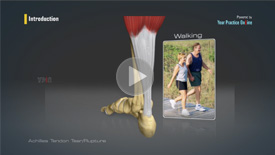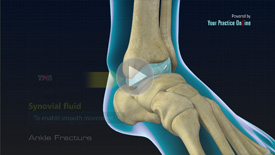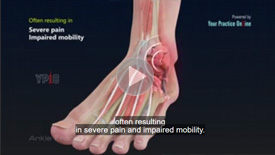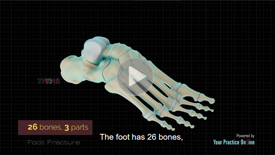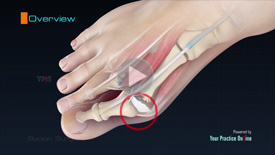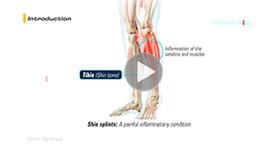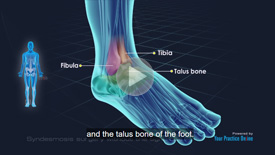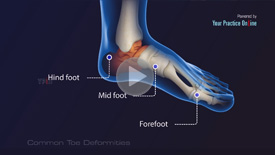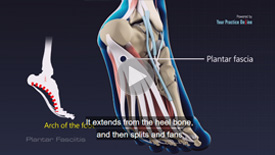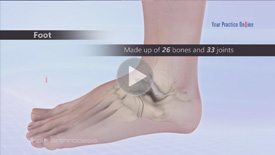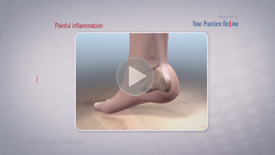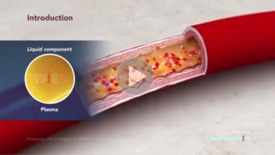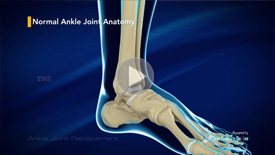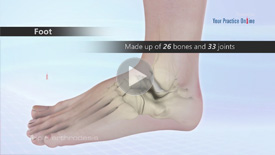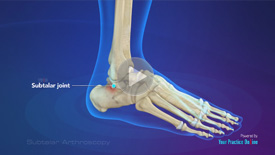Foot & Ankle
Foot & Ankle Anatomy
The foot and ankle is a complex joint involved in movement and providing stability and balance to the body. The foot and ankle consists of 26 bones, 33 joints, and many muscles, tendons and ligaments. Read More
Conditions
Ankle Sprain
A sprain is the stretching or tearing of ligaments, which connect adjacent bones and provide stability to a joint. An ankle sprain is a common injury that occurs when you suddenly fall or twist the joint or when you land your foot in an awkward position after a jump. Read More
Achilles Tendon Rupture
Achilles tendon is a strong fibrous cord present behind the ankle that connects the calf muscles to the heel bone. It is used when you walk, run and jump. The Achilles tendon ruptures most often in athletes participating in sports that involve running, pivoting and jumping. Read More
Plantar Fasciitis
Plantar fasciitis refers to inflammation of the plantar fascia, a thick band of tissue that lies at the bottom of the foot. It runs from the heel bone to the toe and forms the arch of your foot. Plantar fasciitis is one of the most common causes of heel pain. Read More
Ankle Fractures
The ankle joint is composed of three bones: the tibia, fibula, and talus which are articulated together. The ends of the fibula and tibia (lower leg bones) form the inner and outer malleolus, which are the bony protrusions of the ankle joint that you can feel and see on either side of the ankle. Read More
Foot Fracture
The hind foot is separated from the midfoot by the medio tarsal joint and the midfoot is separated from the forefoot by the lisfranc joint. Muscles, tendons and ligaments support the bones and joints of the feet enabling them to withstand the entire body's weight while walking, running and jumping. Read More
Bunion
A bunion is a bony protuberance that appears on the external surface of the big toe when it angles toward the adjacent toe. It is an extra bone and a fluid-filled sac that grows at the base of the big toe. Read More
Ankle Instability
Ankle instability is a chronic condition characterized by a recurrent slipping of the outer side of the ankle. It usually results from repeated ankle sprains. It is generally noticed during movement of the ankle joint but can also occur during standing as well. Read More
Osteochondral Injuries of the Ankle
The ankle joint is an articulation of the end of the tibia and fibula (shin bones) with the talus (heel bone). Osteochondral injuries, also called osteochondritis dissecans, are injuries to the talus bone, characterized by damage to the bone as well as the cartilage covering it. Read More
Stress Fracture of the Foot
A stress fracture is a small crack in the bone which occurs from overuse injury. It commonly develops in the weight-bearing bones of the lower leg and foot. When the muscles of the foot are overworked, or stressed, they are unable to absorb the stress and transfer it onto the bone, which cracks under the pressure. Read More
Shin Splints
Shin splints or medial tibial stress syndrome (MTSS) is pain around the tibia or shin bone due to inflammation of the tendons, muscles and bone tissue. It occurs because of vigorous physical activity such as with exercise or sports. Read More
Heel Fractures
The calcaneus or heel bone is a large bone found at the rear of the foot. A fracture is a break in a bone from trauma or various disease conditions. The types of fracture to the calcaneus depend on the severity and include stable fractures, displaced fractures, open fractures, closed fractures and comminuted fractures. Read More
Lisfranc (Midfoot) Fracture
The Lisfranc joint or tarsometatarsal joint refers to the region in the middle of the foot. It is a junction between the tarsal bones (seven bones in the foot arch) and metatarsal bones (five long bones in the foot). Lisfranc fracture scan occur due to a fall from a height or traumatic motor accidents. Read More
Talus Fractures
The talus is a small bone at the ankle joint that connects the heel bone and the shin bones, enabling the up and down movement of the foot. Fractures in the talus bone may occur due to a fall from great heights, motor vehicle accidents or sports injuries. Read More
Toe & Forefoot Fractures
The forefoot is the front of the foot that includes the toes. Fractures occurring in this part of the foot are painful, but very often not disabling. There are 2 types of fractures namely, traumatic fracture and stress fracture. Traumatic fractures occur when there is a direct impact of your foot on a hard surface. Read More
Foot & Ankle Trauma
Foot and ankle trauma refers to the injuries that most commonly occur during sports, exercise or any other physical activity. Trauma may be a result of accidents, poor training practices or use of improper gear. Injuries may also be caused when an individual is not medically fit or because of insufficient warm up and stretching exercises. Read More
Ankle Ligament Injury
Ankle ligament injury, also known as ankle sprain, can be caused by a sudden twisting movement of the foot during any athletic event or during daily activities. It is one of the most common orthopaedic injuries and can also be caused by walking down a slope or over any uneven surface. Read More
Ankle Injury
Osteochondral injuries are one of the most common causes of ankle pain. Though in most cases there is a history of injury or trauma to the ankle joint, a few cases may not have any previous history of ankle injury. Read More
Achilles Tendon Bursitis
Achilles tendon bursitis or retrocalcaneal bursitis is a condition that commonly occurs in athletes. It is a painful condition caused by swelling of bursa, a fluid-filled sac which is located at the back of the heel under the Achilles tendon. This retrocalcaneal bursa contains a lubricating fluid that acts as a cushion to reduce friction between muscle and bones. Read More
Forefoot Pain
Forefoot pain, also referred to as metatarsalgia, is a type of pain that occurs in the ball of the foot (around the tip of the metatarsal bones). Generally, forefoot pain is associated with aging. Individuals with metatarsalgia experience pain of varied intensity and discomfort and find difficulty in activities like walking, running, playing, and several others. Read More
Intoeing Pain
In toeing also called "pigeon-toed", is an abnormal condition characterized by inward facing of the toe or feet instead of being straight. Parents may observe their children having intoeing at an early age when they start walking. But usually intoeing corrects itself without any specific treatment as the child grows up to around 8 years of age. Read More
Foot Pain
Foot pain occurs from distress induced by certain factors in the foot. Foot pain is a common problem experienced by young athletes involved in different activities such as running and jumping. Read More
Flatfoot
Flatfoot, also known as "fallen arches" or Pes planus, is a deformity in children's feet in which the arch that runs lengthwise along the sole of the foot has collapsed to the ground or not formed at all. Flatfoot is normal in the first few years of life as the arch of the foot usually develops between the age of 3 and 5 years. Read More
Fungal Nails
Fungal infections are common in nails, and occur most often in toe nails. Termed as onychomycosis, nail fungus affects the keratin, the hard material that makes up the nail and can include the entire nail or a portion of the nail, along with the nail root, plate or bed. Read More
Hammertoe
A hammertoe is a deformity of a lesser toe (second through fifth toes), where the toe gets bent upward at the toe's middle joint, resembling a hammer. The bent portion may rub against a shoe causing pain, irritation and development of corns. Read More
Mallet Toe
Mallet finger is a condition where the end of the finger is bent and does not straighten. It occurs when the extensor tendon on the back of the finger is damaged. The finger joint is a hinge-joint that allows bending and straightening of the fingers. Each finger is composed of 3 phalanges bones, joined by 2 interphalangeal joints (IP joints). Read More
Claw Toe
Claw toe is a deformity, where a toe bends and appears like a bird's claw. The affected toe is bent upward from the joint at the ball of foot, and downward at the joints in the middle and tip of the toe to curl under the foot. Hard thick skin called corns may develop under the ball of the foot or on the top of the affected toe, causing pain while walking. Read More
Limb Deformities
Limb deformities can be congenital (present at birth) or develop at a later stage because of fracture, infection, arthritis or tumor. Congenital deformities of the lower limbs are developmental disorders that cause alterations in the shape and appearance of the legs. Read More
Ingrown Toenail
An ingrown toenail is a common and painful condition of the toe. It occurs when the sides or corner of the nail grow inwards and penetrates the skin of the toe. Pain is often accompanied by swelling and redness. The big toe is affected most often. Read More
Corns
A corn is a circular area of thickened skin developed because of continuous friction or pressure. They usually develop on the soles of feet, or on the top or sides of toes, and appear as yellowish dead tissue surrounding an area of tenderness. Pain and discomfort may be present with walking, which can get more painful without treatment. Read More
Heel Pain
The heel is made up of the calcaneus bone and supported by a network of muscles, tendons, ligaments and soft tissues, which together support the weight of the body and stress during movement. Heel pain is a common symptom of excessive strain placed on these structures. Read More
Nail Bed Injuries
The nail is composed of a nail plate, nail matrix and nail bed. The nail bed is the soft tissue that lies below the nail and is essential for the growth of the nail. Nail bed injuries such as crush, and avulsion injuries are commonly associated with injuries to the hands or fingertips. Read More
Turf Toe
Turf toe is an injury to the ligament at the base of the big toe. It is a painful condition which usually results from jamming of the toe into the ground or excessive backward bending of the toe. As it is more common in athletes playing on artificial turf, especially those involved in field sports such as football, baseball and soccer, it is known as turf toe. Read More
Athlete's Foot
Athlete's foot also known as tinea pedis, is a fungal infection on the skin of the foot. It is characterized by itchy, moist, white, scaly lesions between the toes that can spread to the sole of the foot. Athlete's foot is contagious and spreads through contact with infected skin scales or fungi in moist areas such as swimming pools and bathrooms, or from sharing shoes of an infected person or having contact with pets carrying the fungi. Read More
Morton's Neuroma
Morton's neuroma refers to a nerve injury between the toes, usually the third and fourth toes, which causes pain and thickening of the nerve tissue. Compression or chronic irritation of this interdigital nerve is the main cause of Morton's Neuroma. Read More
Foot Infections
Foot infections may occur after trauma to the foot or loss of tissue because of contamination from foreign material and/or bacteria or fungus. Infections can occur in healthy individuals as well as in those whose health is compromised. Read More
Foot Drop
Foot drop also known as drop foot, is a sign of an underlying muscular, neurological or anatomical condition, where you are unable to lift the front part of your foot, resulting in foot dragging. To avoid dragging your foot, you may lift your knee higher than usual as if you were climbing stairs or swing your leg in a wide arc, causing you to slap your foot on the ground every time you step forward. Read More
Club Foot & Congenital Deformity
Congenital deformities of the lower limbs are developmental disorders that are present at birth, causing alterations in the shape and appearance of the legs. Several factors such as genetics, teratogenic drugs and chemicals can cause congenital deformities. Read More
Procedures
Non-surgical Treatments
Platelet Rich Plasma Therapy
Our blood consists of a liquid component known as plasma. It also consists of three main solid components which include the red blood cells (RBCs), white blood cells (WBCs), and platelets. Platelets play an important role in forming blood clots. Read More
Foot Care
Feet support your body weight, help maintain proper posture and help in movement. As the feet bear the entire weight of the body and are involved in most activities, they are more prone to problems such as calluses, corns, cracks, infections and traumatic injuries. Read More
Foot Activity & Exercise Guide
A foot injury or foot surgery may leave you immobile for a period. To return to your regular activities and more strenuous recreational activities, it is necessary for you to follow a well-planned activity and exercise program. Read More
Surgical Treatments
Bunion Surgery
A bunion, also known as hallux valgus, is bony prominence at the base of the big toe, which often results in pain, redness and rubbing in footwear. The 1st metatarsal bone abnormally angles outward towards the other foot from its joint in the midfoot. Read More
Ankle Joint Replacement
The ankle joint connects the leg with the foot and provides free movement to the foot. It is formed by connecting the bones of the lower leg, tibia and fibula, with the talus, or ankle bone. Read More
Ankle Arthroscopy
Ankle arthroscopy is a minimally invasive surgical procedure in which an arthroscope, a small, soft, flexible tube with a light and video camera at the end, is inserted into the ankle joint to evaluate and treat a variety of conditions. Read More
Ankle Instability Surgery
Ankle instability is a chronic condition characterized by a recurrent slipping of the outer side of the ankle. Instability is generally noticed during movement of the ankle joint but can also occur during standing as well. Read More
Ankle Arthrodesis
Ankle arthrodesis is the surgical fusion of bones that form the ankle joint. The ankle joint is formed by the tibia, talus, and the fibula bones. Read More
Foot Reconstruction
Foot reconstruction is a surgery performed to correct the structures of the foot and restore the natural functionality of the foot that has been lost due to injury or illness. Ideally, any foot surgery for reconstruction is done to improve the appearance and function of the foot so that patients can maintain their quality of life. Read More
Subtalar Arthrodesis
Subtalar arthrodesis is the surgical fusion of bones that form the subtalar joint. The subtalar joint is a complex joint located below the ankle joint and is formed by the union of the heel (calcaneus) and the talus (ankle) bone. Read More
Minimally Invasive Foot Surgery
Minimally Invasive Foot Surgery (MIFS) uses the latest advanced technology to treat foot and ankle pain caused by a variety of conditions. Special surgical instruments, devices and advanced imaging techniques are used to visualize and perform the surgery through small incisions. Read More
Ankle Ligament Reconstruction
An ankle sprain is a common injury and occurs when you fall or suddenly twist the ankle joint or when you land your foot in an awkward position after a jump. It most commonly occurs when you participate in sports or when you jump or run on a surface that is irregular. Read More
Ankle Tenotomy
Ankle tenotomy is a surgical procedure to lengthen the Achilles tendon enabling the ankle to flex upward and allowing the heel to be placed flat on the floor. It is indicated in patients that have an abnormally developed Achilles tendon or one that has become shortened and difficult to stretch. Read More
Treatment of Foot and Ankle Sports Injuries
Injuries during sports are common. They can result from accidents, inadequate training, improper use of protective devices, or insufficient stretching or warm-up exercises. Injuries to the foot and ankle are common while playing sports such as football, hockey, skating and in weekend athletes. Read More
Cavovarus Foot Correction
To support the entire body’s weight on your two feet, the inner middle portion of each foot (midfoot) is raised off the ground to form an arch. A cavovarus foot deformity is characterized by a higher-than-normal arch of the inner midfoot. Read More
Flatfoot Reconstruction
Foot reconstruction is a surgery performed to correct the structures of the foot and restore the natural functionality of the foot that has been lost due to injury or illness. Read More








